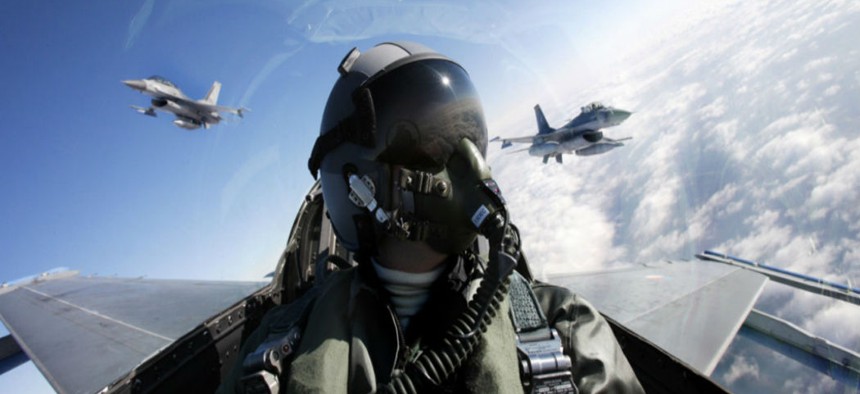Next-gen biometric sensors monitor pilot distress
The Air Force is working on aircraft technology that will automatically adjust flight systems to keep pilots healthy and secure.
Flying at extremely high speeds means that pilots have to make split second decisions in response to vast amounts of incoming data. Faced with so much information, pilots sometimes fail to monitor the signals of their own bodies during flight. But what if the aircraft could do it for them?
This is the question that researchers at the Air Force Research Laboratory are currently investigating, according to James Christensen, Portfolio Manager at the 711th Human Performance Wing of the Air Force Research Laboratory.
“We built aircraft that are incredible sensor platforms that collect data on the world around them and on the aircraft systems themselves,” he explained. “Very little data is being collected on the pilot, so the opportunity there…is to provide a continuous monitoring and assessment capability so that the aircraft knows the state of the individual [pilot],” he said at the 2017 Defense One Tech Summit last week.
For example, the pilot’s flight suit could have small, built-in sensors around the pilot’s chest or other areas to monitor heart rate, body temperature, and other biometric data. If these sensors indicated a loss of consciousness, the aircraft could automatically “unload Gs,” Christensen said.
Gs, or G-forces, are essentially the forces of gravitational acceleration experienced by pilots, according to the Federal Aviation Administration If not properly mitigated, changes in the speed or altitude of aircraft can occur faster than the pilot’s body can adjust and blood flow can be inhibited by gravity. According to Christensen, this would be one case where the pilot would start to lose his or her sight and then consciousness, and aircraft sensors would alter the flight to bring the pilot back to full alert.
“It’s about adapting the response of the automated systems that [the pilots] are working with…are [the pilots] awake? Alert? Fully capable of performing their roles as part of that man-machine system? …Then there are things that the aircraft can do…to reduce the strain on the pilot to get them back to maximum performance,” said Christensen.
This project is increasingly relevant in light of the continued search for the cause of the hypoxia symptoms suffered by pilots stationed at Luke Air Force Base in late May and early June. According to Col. Patrick Ryder, Chief of the Current Operations Division of Air Force Public Affairs, the incidents led to an 11-day flying hiatus and subsequent investigations yielded little explanation beyond ruling out maintenance and air crew handling fault.
The Air Force did report that in all cases, the pilots were able to engage the aircraft’s back-up oxygen system to land safely. However, with the new biometric sensor technology being developed, the aircraft’s sensors could potentially pick up on biological signs of hypoxia before the pilot became aware of his or her own symptoms. The aircraft would then automatically take measures to adjust the cockpit environment, and the pilot might not even have to deviate from a mission or flight path.
Boeing has conducted studies on monitoring pilot heartrates for alertness levels using flight simulators. However, the Air Force Research Laboratory’s project will be the first time sensors monitor pilots in flight, and input the data directly into the automated flight systems.
Wearable biometric sensors for humans are still being developed and perfected, according to Dr. Justin Sanchez, Director of the Biological Technologies Office at DARPA. Yet, aircraft that autonomously adjust their flight systems in response to low oxygen levels, even before the pilot is aware of the issue, might well be the new normal for the next generation of fighter pilots.




